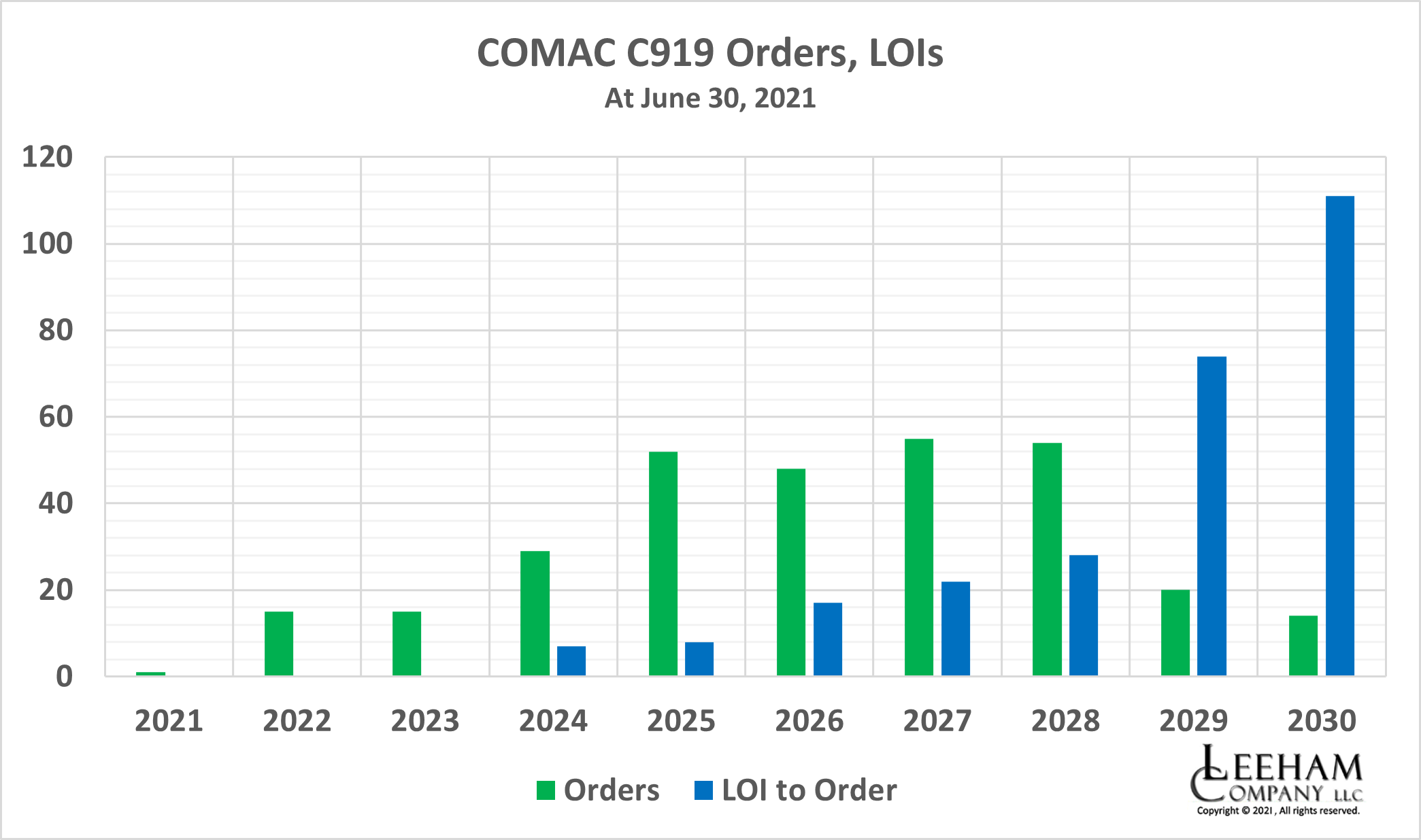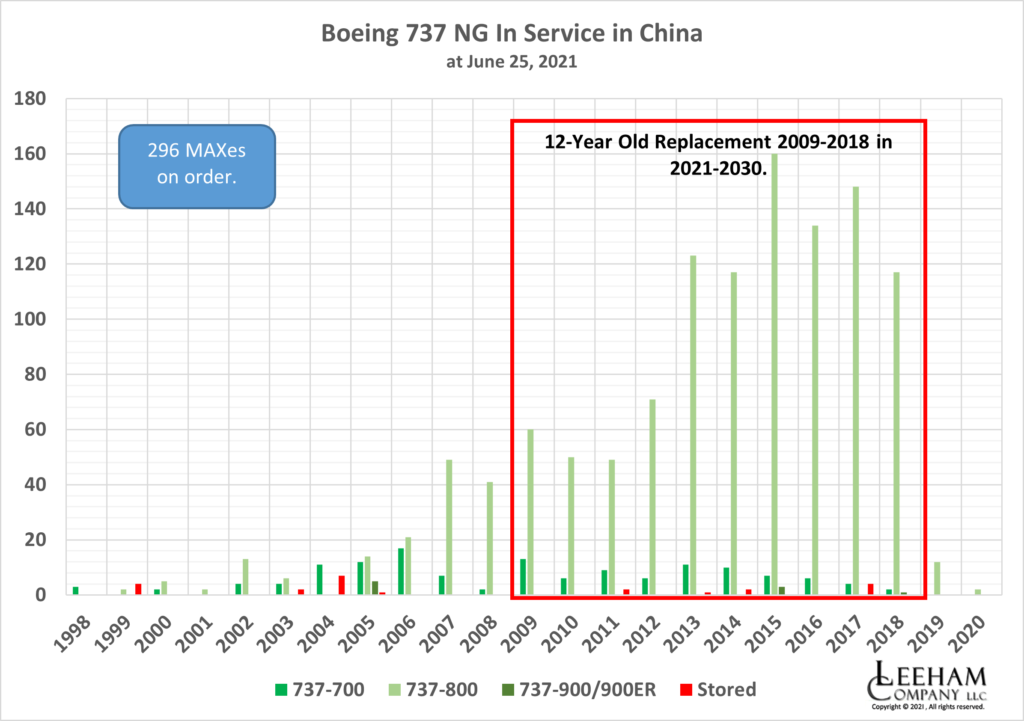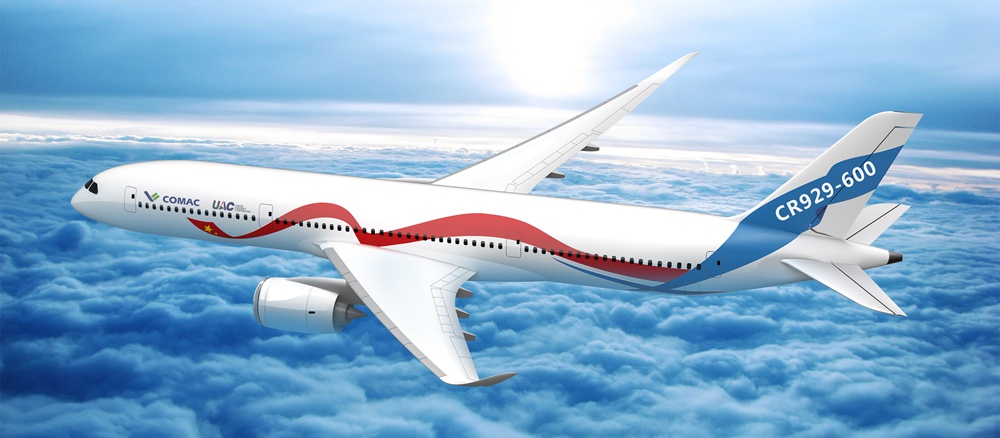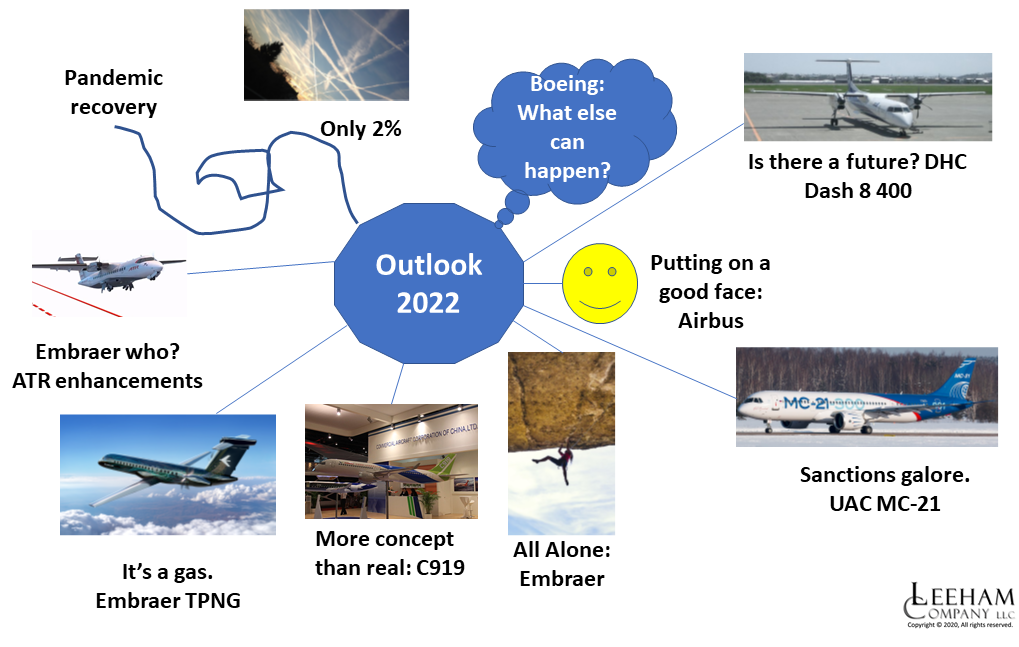Leeham News and Analysis
There's more to real news than a news release.
2022 Outlook depends largely on pandemic, Boeing recovery
Subscription Required
By the Leeham News Team
Dec. 13, 2021, © Leeham News: Attempting a forecast for the new year historically has been reasonably easy. One just started with the stability of the current years, and maybe the previous one or two years, and looked forward to next year.
Until the Boeing 737 MAX grounding, COVID-19 pandemic, and the Boeing 787 suspension of deliveries.
These events upended everything. Boeing’s outlook for 2020 depended on what happened to return the MAX to service. The grounding, initially expected by many to be measured in months, ultimately was measured in years.
The 2020 outlook for the rest of the aircraft manufacturers blew up that March with the global pandemic.
Then, in October 2020, Boeing suspended deliveries of the 787, exacerbating its cash flow crunch.
Commercial aviation began to recover some in late 2020. Airbus, which reduced but didn’t suspend deliveries throughout 2020, saw signs of hope for the narrowbody market—less so for widebody airplanes.
There is a lot of uncertainty, however, that makes looking even one year ahead challenging.
C919 EIS target year end; production rate forecast is aggressive
Subscription Required
By Scott Hamilton
Introduction
Sept. 13, 2021, © Leeham News: The first COMAC C919 is supposed to be delivered to China Eastern Airlines before the end of the year.
If so, it will be the milestone of the program launched in 2008, 13 years ago, becoming one of the longest launch-to-EIS in aviation history. COMAC’s ARJ 21 took one year longer. This regional airliner program was launched in 2002. Entry-into-service was in 2016.
The C919 is China’s direct challenge to the Airbus A320 and the Boeing 737. Similar in appears to the A320, for which there is an assembly line in Tianjin, the C919 is powered by the CFM LEAP 1C and a domestically-produced engine. But the C919 only has an advertised range of 2,200-3,000nm. The A320 and 737-8 have ranges of 3,500 and 3,550nm, respectively.
COMAC forecasts producing 150 C919s a year by the middle of this decade. Achieving this rate in this period should be a major challenge. Based on normal learning curves, a more realistic ramp up to 150 a year will take until early 2031.
Summary
- China forecasts a production rate of 150/yr by the middle of the decade.
- History suggests a much lower rate by then.
- LNA’s production rate forecast is detailed through 2030.
Here’s why China needs Boeing as much as Boeing needs China
Subscription Required
Now open to all readers.
July 7, 2021, © Leeham News: China’s government policy of operating commercial aircraft that generally are no more than 12-15 years old means the carriers face a replacement bubble that the home market can’t possibly meet.
According to data reviewed by LNA, there are just 303 COMAC C919s on order. Delivery is supposed to begin this year with one airplane. Currently, the peak year for deliveries is 2027 with 55 aircraft scheduled.
There are about 1,116 Boeing 737 NGs built between 2008-2018 operated and stored by Chinese carriers. China has just 296 737 MAXes on order—a deficit of 820 aircraft needed for replacement of these aging airplanes. (Boeing’s website shows just 104 outstanding orders, but Chinese-owned lessors aren’t included in this tally.)
Pontifications: The WTO Airbus/Boeing standstill and pursuing China
June 28, 2021, © Leeham News: The US and European Union agreed on June 15 to a standstill in the 17-year old trade dispute over illegal subsidies to Airbus and Boeing.
The World Trade Organization (WTO) found each violated international rules. By the time all was said and done, the US was authorized to levy tariffs on $7.5bn worth of European goods. The EU received authorization to levy tariffs on $4bn of US goods.
Tariffs on goods went beyond Airbus and Boeing products. But it was 15% tariffs on Airbus planes imported into the US and Boeing planes imported into the EU that were the highest-profile and most costly.
Despite initial reports in some uninformed media that the long-running dispute was “resolved,” in fact, only a standstill was agreed. The US and EU now have five years to negotiate a permanent settlement to Airbus’ “reimbursable launch aid” and Boeing’s benefits from tax breaks and NASA.
The two sides also agreed to put China’s commercial aerospace industry in the crosshairs.
Podcast: 10 Minutes About China’s Commercial Aviation Industry
Jan. 19, 2021, © Leeham News: Today’s edition is 10 Minutes About China’s commercial aviation industry. 
China has one airliner in service, a second in flight testing and a third on the drawing board. Production is still a challenge.
We discuss how viable the airliners are and a bit about production–all in 10 minutes.
Outlook 2021: Russia and China
Subscription Required
By Bjorn Fehrm
Introduction
Jan. 14, 2021, © Leeham News: China and Russia are both developing a single-aisle domestic airliner in the A320/737 MAX class, a regional turboprop in the ATR 72 class, and is jointly working on an A330neo/787 widebody competing airliner.
While these are similar development programs, the countries are in very different positions in their markets and industries. China is a five times larger market for airliners than Russia, and its airlines are on the way back from COVID riddled passenger numbers. It has the fastest recovery from COVID-19 of any country and its civil airliner industry is on the rise.
Russia on the other hand has a stagnant market, still hit by COVID-19, and its market and industry have become introverted after a decade of flirting with Western markets and technology.
 Summary
Summary
- China and Russia drive almost identical civil airliner projects to replace Soviet-era and Western airliners.
- While similar in their projects, they are different in their markets and state of industries.
- China is on the way up (albeit from a low state) to eventually compete on the world market, whereas Russia is falling back to a Soviet-style all Russian state-controlled model.
Pontifications: Outlook 2021 Series begins today
Jan. 4, 2021, © Leeham News: Beginning today through next week, Leeham News presents its annual Outlook series for the coming year.
We’ve been doing this for years. In recent years, the Outlook reflected continued growth in commercial aviation. The industry had the longest upward tick in the more than three decades I’ve been involved in the sector.
Not this year. As I wrote before the Christmas-New Year’s holiday period, 2020 was the worst year for commercial aviation I’ve ever seen in 41 years.
This year is the beginning of the end of the COVID crisis. Yes, the vaccines began distribution in December, but large spikes in COVID cases began simultaneously and are predicted to climb higher through the first quarter.
Over the coming days, as LNA provides its Outlook for 2021, readers will see what we believe will happen.
Pontifications: The risk of closing China to aerospace suppliers
Nov. 30, 2020, © Leeham News: The Trump Administration this month indicated it might expand its ban on doing business with certain Chinese companies.
The Administration says the additional companies have ties to the military. Included in the listing is COMAC.
Reuters reported the move Nov. 13.
If the Administration follows through during its remaining lame-duck time in power, and if the new Biden Administration doesn’t reverse or modify the plan, the long-term effect could hurt the US aerospace supply chain.
2024 will be key year for Boeing in Washington
This is the second in a series of articles examining how labor, Boeing and Washington state could move forward following the COVID pandemic. The first article is here.
Subscription Required
By Bryan Corliss
Analysis
Introduction
Nov. 30, 2020, © Leeham News — You might want to set yourself an Outlook calendar reminder for January 2024.
It’s going to be a pivotal year for Boeing, its home state and its workforce. By then, the company’s recovery from the current Covid-caused crisis should be underway, with the order book refilling.
The countdown should be on for the long-delayed roll-out of the reconceived NMA, at long last giving Boeing a real counter to the Airbus A321. And — barring a surge in 737 MAX orders after its return to service — Boeing could be close to making some tough decisions about the future of the 737 program, thinking hard about whether after 60 years it’s finally time to design and build a clean-sheet replacement.
Also by then, the 787 program will have fully consolidated into Charleston, and the last 747 will have departed the Paine Field flight line, leaving The World’s Largest Building (By Volume) half-empty.
Then, in January 2024, Boeing’s contract with its touch-labor union – IAM District 751 – will expire, after a 10-year extension that was part of the price Machinists paid to ensure the 777X would be assembled in Everett. For the first time since the summer of 2008, the two sides will sit down at a bargaining table with the union having the ability to call for a strike.
What happens between now and January 2024 will pretty much decide the future of Boeing in Washington state. If the players are clear-eyed and rational, we could see a return to the days when high-skilled workers built high-quality planes that created handsome profits for Boeing shareholders and family-wage jobs for Boeing workers.




